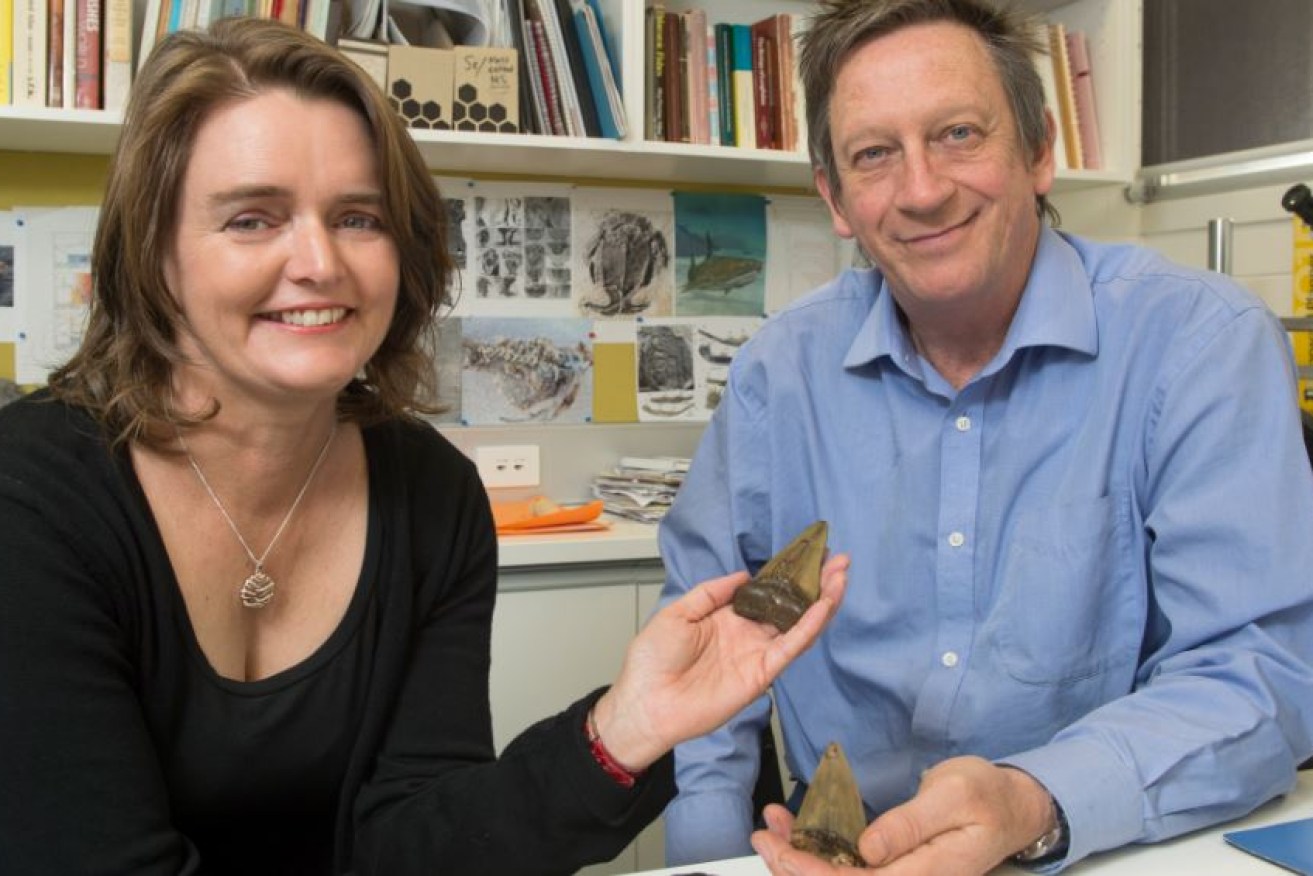
Inland sea paves way for world-class opals

Dr Danielle Clode and Flinders University’s Strategic Professor in Palaeontology John Long and fossilised shark teeth. Dr Clode will speak at the SA Museum next week (Wednesday 14 October 2015).
Australian museums and Outback fossickers can thank the events of 100 million years ago for their fossil treasures and high-quality opals.
Near perfect conditions for the creation of these “particularly beautiful” relics were created in prehistoric times when Australia’s red centre was flooded by an inland ocean called the Eromanga Sea, says Flinders University research fellow Dr Danielle Clode.
This was one of the interesting facts “unearthed” by Dr Clode in her latest book Prehistoric Marine: Life in Australia’s Inland Sea (Museum Victoria, RRP $24.95).
She will join Flinders University Professor Allan Pring, the South Australian Museum’s former Head of Minerals, for an evening lecture entitled Opals: The 100 million year story at the SA Museum on Wednesday 14 October. The museum’s Opals Exhibition runs to 14 February 2016.
A “Virgin” belemnite (cephalopod-like blade) and fossilised ammonite form part of the extensive SA Museum opal collection.
“The reason why Australia has significantly more opals than anywhere else in the world is because of the specific sedimentary activity of this vast, shallow sea,” Dr Clode says.
“These prehistoric conditions and ocean’s gradual retreat saw large-scale opalisation of a wide array of prehistoric marine life, including giant reptiles and other creatures swimming and roaming the shoreline, skies and shallow sea water.
“They yield a rich and enduring understanding of life in those prehistoric times which palaeontologists can now piece into a colourful picture of Australia’s Eromanga Sea during the Cretaceous period.”
The new illustrated book gives an accessible introduction to some of the amazing fauna, geology and fossils found in central Australia, says Dr Clode, a writer and researcher in the School of Creative Arts, who worked in collaboration with palaeontologists at the SA Museum and Flinders University.
Fossilised remains of plesiosaurs, ichthyosaurs, pterosaurs and ammonites have since become major fossil finds in opal-mining districts of South Australia and New South Wales, while western Queensland and Western Australia is known for its dinosaur and marine fossils.
The focus on prehistoric marine animals in Dr Clode’s latest book follows a theme of her six other publications.
Brought up by boatbuilder parents and living on a boat originally based in Port Lincoln saw her cover Australia’s coast from east to west.
Her first book Killers in Eden has just been reprinted by the Museum of Victoria, recounts the history of killer whaling off the South Coast of NSW.
And her current project is an adventure on the high seas, an historical novel about the first French expedition to land on the West Coast of Australia – almost coinciding with the British landing on the East Coast in 1770.
The other titles include Prehistoric Giants: Megafauna of Australia (Museum of Victoria), A Future in Flames (Melbourne University Press), A Continent of Curiosities (Cambridge University Press) and As If For A Thousand Years (Victorian Environmental Assessment Council).
Lecture topic: Opals: the 100 million year story
Celebrating the centenary of discovery of opal at Coober Pedy, the SA Museum invites you to look even further back in time when most of South Australia was covered by an inland sea and the perfect conditions for opal formation were created.
When: Wednesday 14 October from 6pm – 7.30pm
RSVP essential at the link here.




